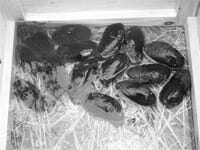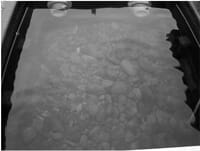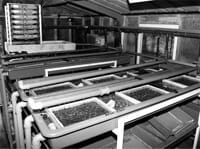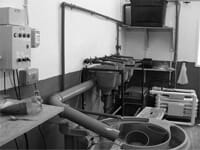It is one of two Margaritifera species to appear on the International Union for the Conservation of Nature and Natural Resources red data list.
The decline in numbers is due to several factors relating to human activity including over-fishing, habitat destruction and pollution.
Recent surveys have demonstrated that there has been no juvenile recruitment in populations in England and Wales for several years and that numbers are decreasing at a rate of 50 per cent every 10 years.
 |
 |
| Adult mussels collected from the River Wye | Broodstock mussel tank at Cynrig Hatchery |
 |
 |
| Seminatural juvenile culture baskets Mawddach Hatchery | Juvenile re-circulation at Glasbury Hatchery |
During its unique lifecycle the FWPM uses juvenile salmonids as a host for its glochidial stage. Glochidia encyst on the gills of salmonids and develop over winter to a juvenile stage capable of surviving when it is released from the fish and settles into the substratum. It is estimated that the survival rate from release of glochidia to juvenile settlement is well below 0.01 per cent.
Studies in the UK have shown that it is possible to collect juveniles after they are released from their salmonid hosts and culture them in seminatural environments to several years of age. However survival rates have been low.
Recent work in North America (Virginia Tech), using small re-circulating systems and specially prepared diets have show that it is possible to achieve very high survival rates of juvenile mussels (up to 70 per cent) over a 12 month period, although growth appears to be reduced compared to the wild.
The Environment Agency Wales (EAW), in conjunction with the Countryside Council for Wales, English Nature and local Wildlife Trusts, have embarked upon a programme of long-term restoration of the FWPM through the Forum of the FWPM Recovery Group. At present EAW Conservation and Hatchery staff have collected adult mussels from six rivers in Wales where populations are failing with the intention of establishing a breeding programme. Restoration efforts will involve stocking out of “infected” fish and culturing juveniles past the “bottleneck” stage of high mortality.
Since 2004, over 200 adult mussels have been sucessfully translocated to the three EAW hatcheries and survival has been excellent. Some river strains have successfully spawned and reproduced, and in the spring of 2006 approximately 100,000 juveniles were collected at Mawddach hatchery.
These juveniles are being cultured in a combination of semi-natural and intensive systems to gauge the best possible conditions for survival. Survival figures for cultured juveniles will be estimated later in the year when sampling will be less damaging.
March 2008

